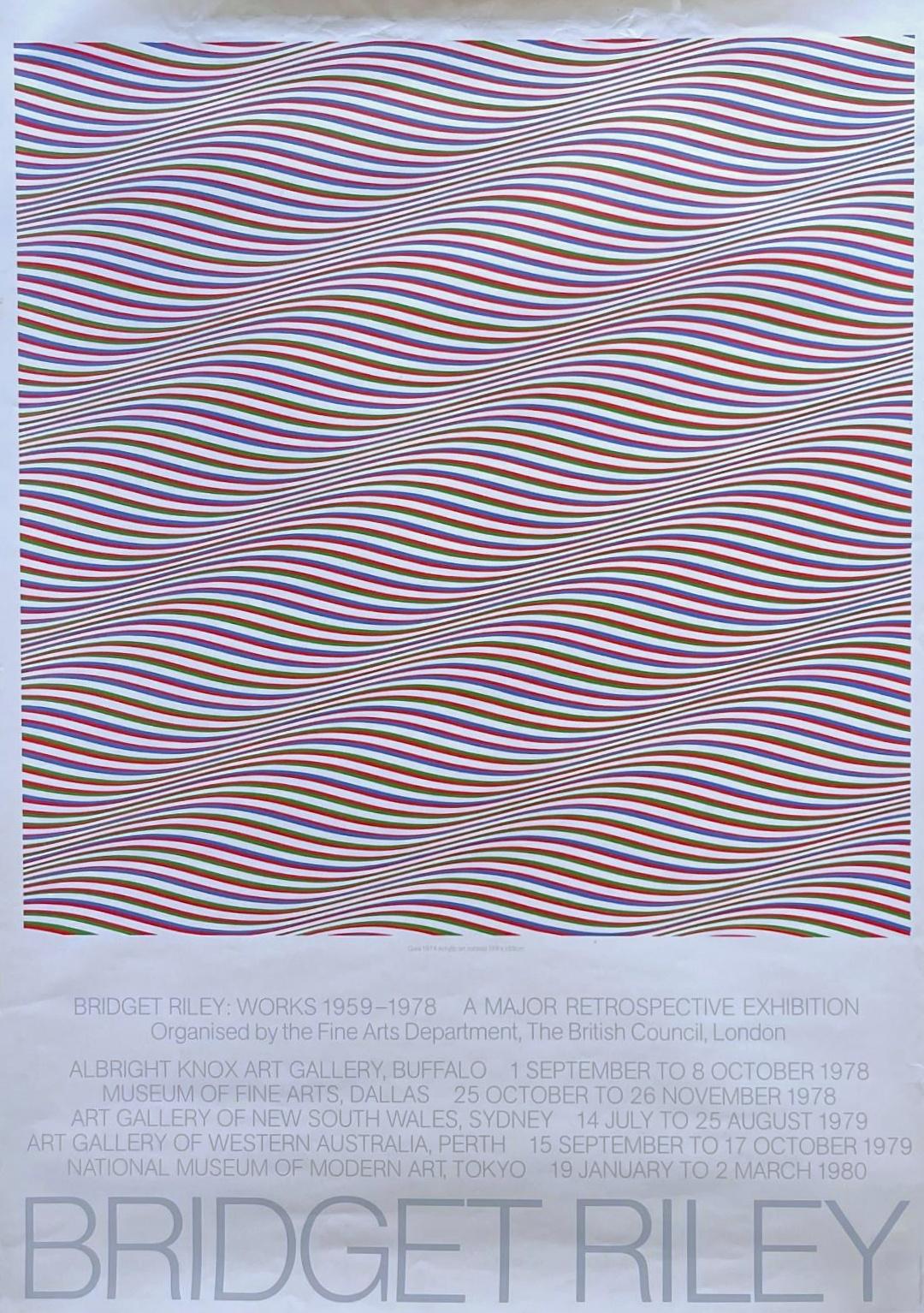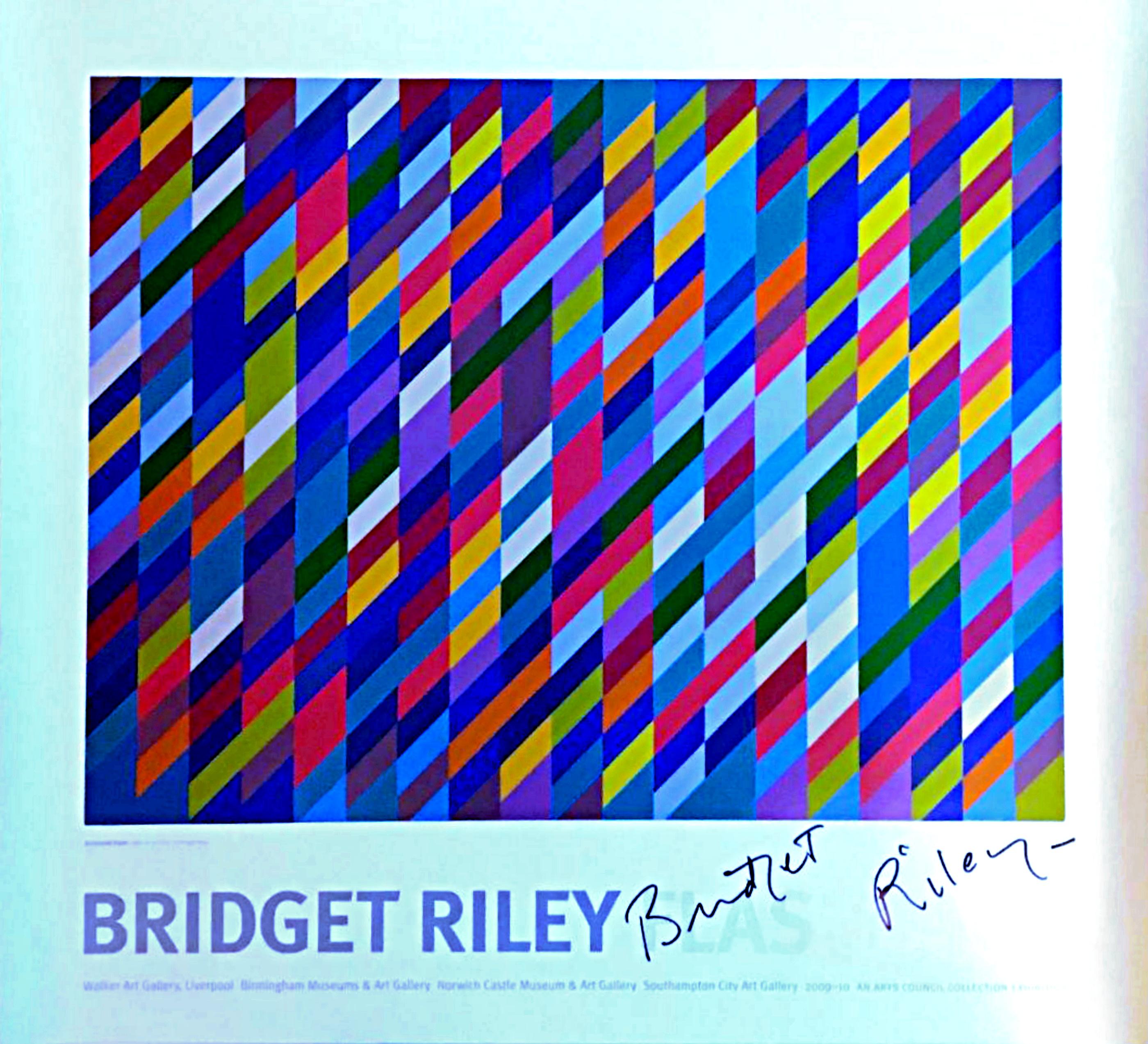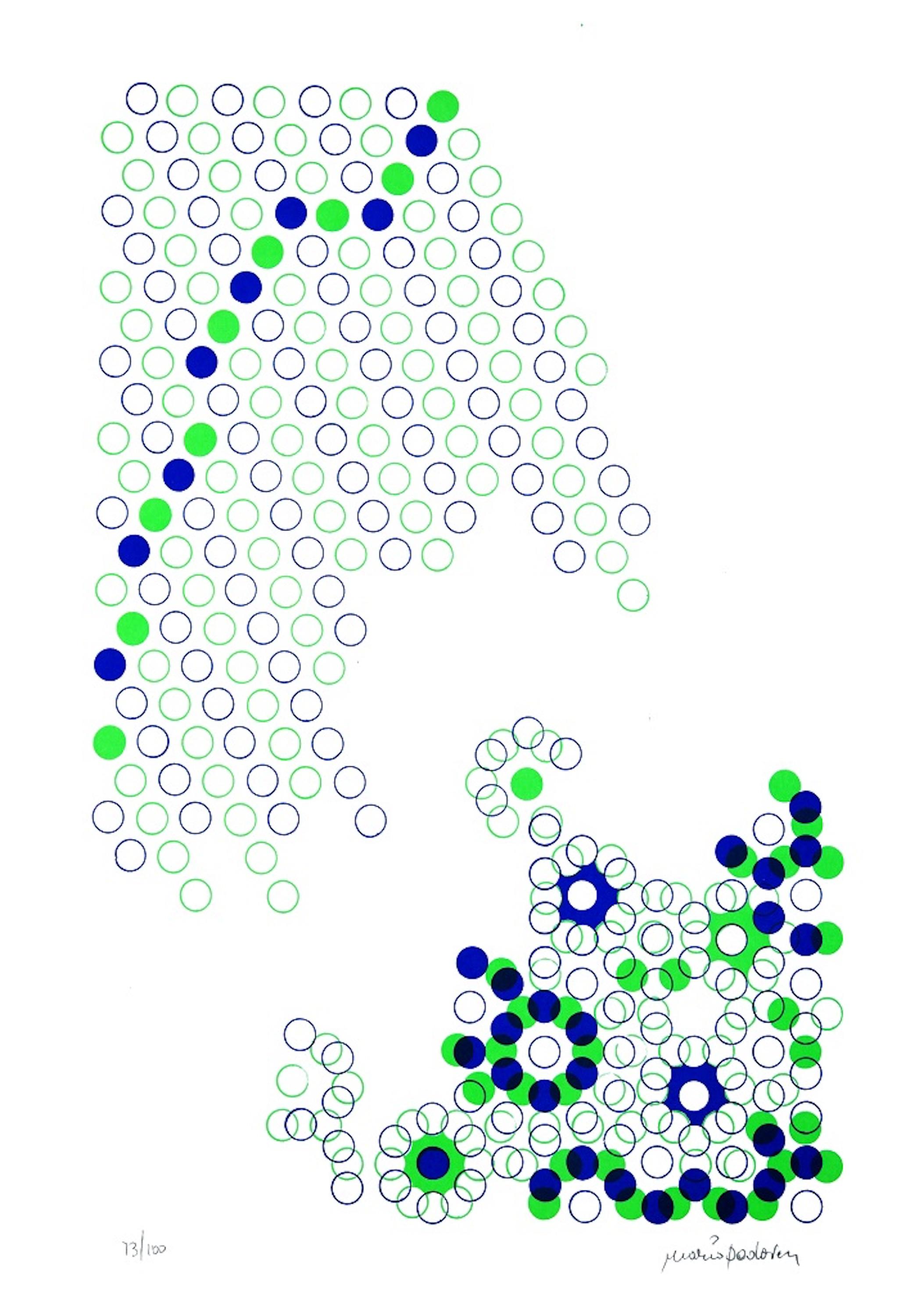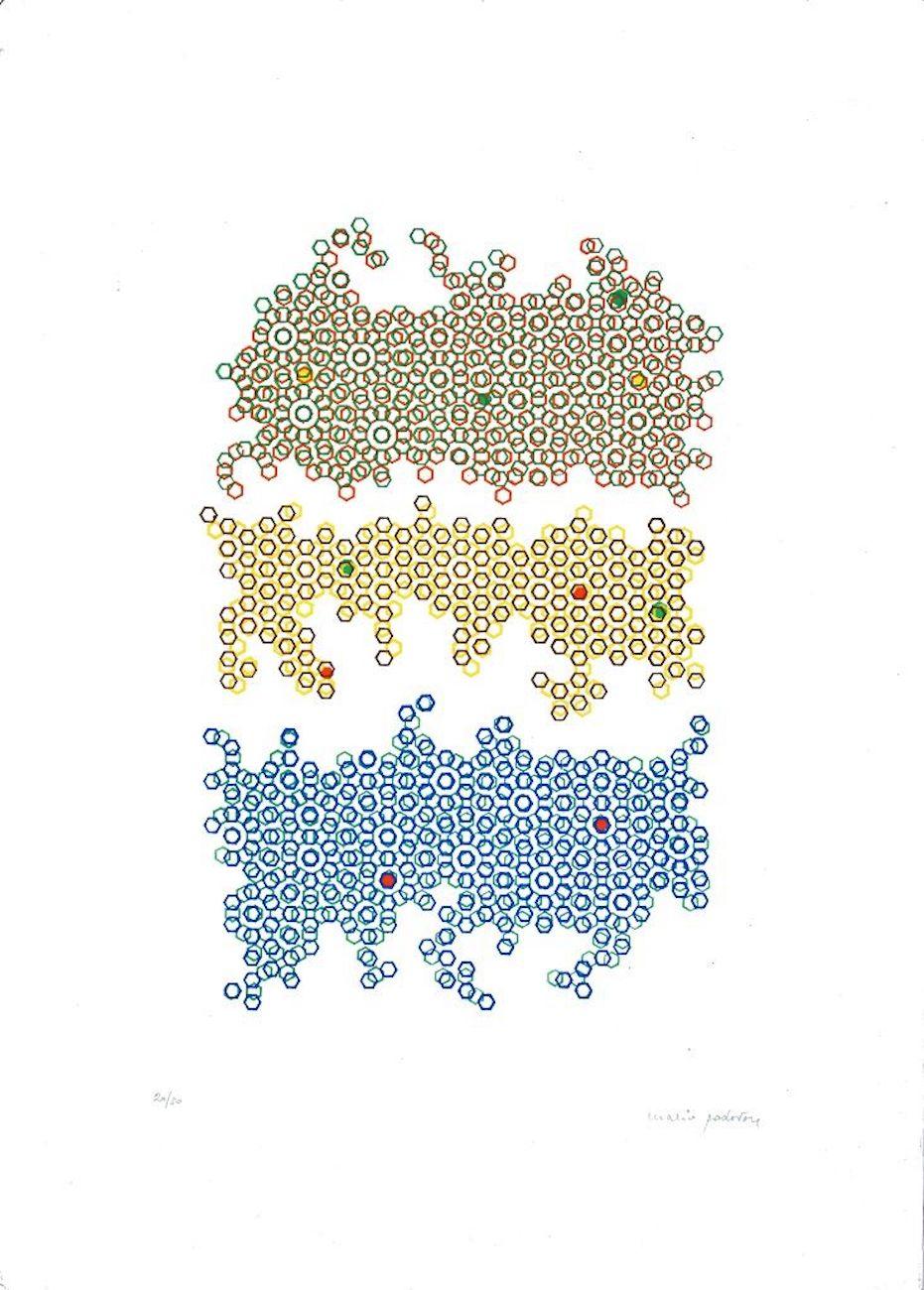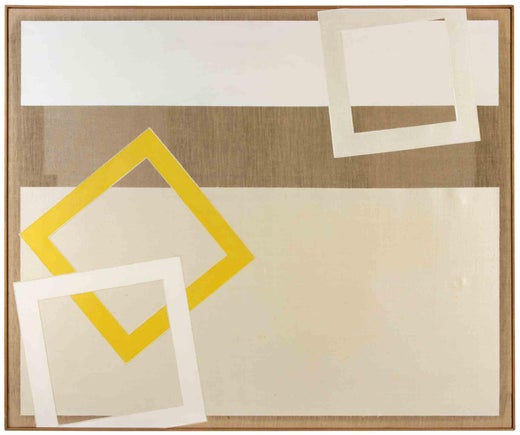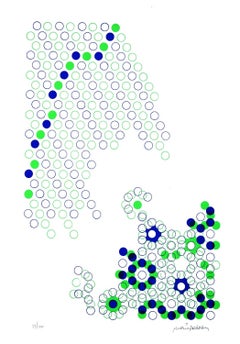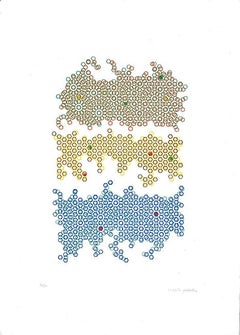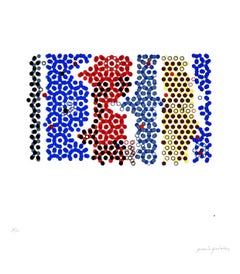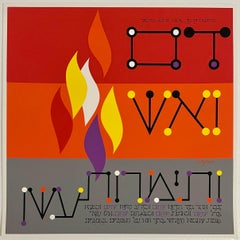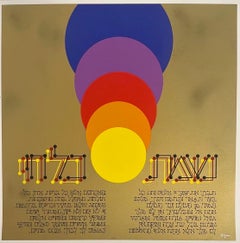Items Similar to The Red Line - Original Lithograph by Mario Padovan - 1970s
Want more images or videos?
Request additional images or videos from the seller
1 of 5
Mario PadovanThe Red Line - Original Lithograph by Mario Padovan - 1970s1970s
1970s
About the Item
The Red Line is an original colored lithograph realized by Mario Padovan in the 1970s.
Hand-signed in pencil on the lower right. Numbered in pencil on the lower left. Edition 2/100.
Good conditions.
The Red Line is a print that belongs to the artist's series of Op Art artworks. In the late sixties and early seventies, indeed, Padovan focused his artistic career on the research on Op Art, a movement that used patterns and colors in painting to elicit disorientating effects on viewers.
Get hypnotized by this mixed-colored artwork where a red line seems to separate two opposite parts, the blue and the green ones.
- Creator:Mario Padovan (1927, Italian)
- Creation Year:1970s
- Dimensions:Height: 27.56 in (70 cm)Width: 19.69 in (50 cm)Depth: 0.04 in (1 mm)
- Medium:
- Movement & Style:
- Period:
- Condition:Insurance may be requested by customers as additional service, contact us for more information.
- Gallery Location:Roma, IT
- Reference Number:Seller: M-1014261stDibs: LU65035238602
Mario Padovan
Mario Padovan is an Italian Postwar & Contemporary painter born in 1927. His exploration of various artistic languages and movements reflects a relentless pursuit of self-expression and a profound engagement with the global artistic landscape. In the forties, Padovan delved into figurative art, beginning his artistic odyssey. The fifties saw him embracing informal art, followed by a foray into the vibrant world of Pop Art in the sixties. The seventies witnessed his experiments with Opt Art and image-splitting techniques, showcasing a willingness to push artistic boundaries. Throughout this journey, Padovan explored diverse materials and techniques, from traditional mediums like oil and acrylics to unconventional choices like colored sand, ready-made objects, paper, wood, steel, and even cold light. These elements, when combined, enriched his artistic expression, creating a multifaceted body of work. Padovan's artistic repertoire expanded to encompass sculpture, conceptual installations, and the creation of artist books to meet his evolving creative needs. Critics aptly labeled him a "creative nomad," acknowledging his responsiveness to inner impulses that guided his artistic evolution. In the eighties, Padovan's focus shifted to the geometry of the square, a fascination that would persist for decades. His exploration of geometric forms evolved into illuminated envelopes, a theme that gained prominence in his works. A significant milestone in Padovan's career occurred in 1984 when he exhibited at the 41st Venice Biennale, following an invitation from Giorgio Di Genova and Giovanni Carandente. Subsequent exhibitions showcased his unique blend of classical art citations, mainly drawing inspiration from the Renaissance and Baroque eras. The artist's geometric interpolations and extrapolations inspired by Bernini's Fontana dei Fiumi and Michelangelo's Sistine Chapel figures were exhibited in Rome, Viterbo, and Ferrara, further solidifying his reputation as an artist with a profound connection to classical art. In 2000, Padovan found inspiration in the baroque angels of Ponte Sant'Angelo in Rome, infusing geometric and light elements to highlight the formal perfection of classical art. This marked a continuous dialogue with the past, a theme encapsulated by Picasso's words: "A mediocre artist imitates while a genius copies." As Padovan approaches ninety, his artistic curiosity remains undiminished. His ongoing studies delve into the coherence of numbers, the aesthetic mystery of Phidias' Golden Mean, modern graphic techniques, universal DNA, and the history of monotheistic religions. This relentless pursuit of knowledge and creativity epitomizes Padovan's "creative madness," a term he uses to describe the enduring passion that fuels his artistic exploration and innovation.
About the Seller
4.9
Platinum Seller
Premium sellers with a 4.7+ rating and 24-hour response times
1stDibs seller since 2017
7,496 sales on 1stDibs
Typical response time: 2 hours
- ShippingRetrieving quote...Shipping from: Monaco, Monaco
- Return Policy
Authenticity Guarantee
In the unlikely event there’s an issue with an item’s authenticity, contact us within 1 year for a full refund. DetailsMoney-Back Guarantee
If your item is not as described, is damaged in transit, or does not arrive, contact us within 7 days for a full refund. Details24-Hour Cancellation
You have a 24-hour grace period in which to reconsider your purchase, with no questions asked.Vetted Professional Sellers
Our world-class sellers must adhere to strict standards for service and quality, maintaining the integrity of our listings.Price-Match Guarantee
If you find that a seller listed the same item for a lower price elsewhere, we’ll match it.Trusted Global Delivery
Our best-in-class carrier network provides specialized shipping options worldwide, including custom delivery.More From This Seller
View AllFluo Composition - Lithograph by Mario Padovan - 1970s
By Mario Padovan
Located in Roma, IT
Fluo Composition is an original colored lithograph realized by Mario Padovan in the 1970s.
Hand-signed in pencil on the lower right. Numbered in pencil on the lower left. Edition 13...
Category
1970s Op Art More Prints
Materials
Lithograph
Emerged Land - Lithograph by Mario Padovan - 1970s
By Mario Padovan
Located in Roma, IT
Emerged Land is an original colored lithograph realized by Mario Padovan in the 1970s.
Hand-signed in pencil on the lower right. Numbered in pencil on the lower left. Edition of 50 ...
Category
1970s Op Art More Prints
Materials
Lithograph
Emerged Land - Lithograph by Mario Padovan - 1970s
By Mario Padovan
Located in Roma, IT
Emerged Land is a colored lithograph realized by Mario Padovan in the 1970s.
Hand-signed in pencil on the lower right. Numbered in pencil on the lower left. Edition of 50 prints num...
Category
1970s Op Art More Prints
Materials
Lithograph
Sinuous Geometries - Original Lithograph by Mario Padovan - 1970s
By Mario Padovan
Located in Roma, IT
Sinuous Geometries is an original colored lithograph realized by Mario Padovan in the 1970s.
Hand-signed in pencil on the lower right. Numbered in pencil on the lower left. Edition ...
Category
1970s Op Art More Prints
Materials
Lithograph
Rhythm 15 - Original Screen Print by Mario Padovan - 1969
By Mario Padovan
Located in Roma, IT
Rhythm 15 is an original colored serigraph realized by Mario Padovan in 1969.
Hand-signed in pencil on the lower right. Numbered in pencil on the lower left. Edition 26/50. Original...
Category
1960s Op Art More Prints
Materials
Lithograph
Optical Composition - Original Screen Print by Mario Padovan - 1973
By Mario Padovan
Located in Roma, IT
Optical Composition is an original colored serigraph realized by Mario Padovan in 1973.
Hand-signed in pencil on the lower right. Numbered in pencil on the lower left. Edition 71/10...
Category
1970s Op Art More Prints
Materials
Lithograph
You May Also Like
Historic limited edition 1960s retrospective poster British Council Pop Op Art
By Bridget Riley
Located in New York, NY
After Bridget Riley
Bridget Riley Works 1959-1978: A Major Retrospective Exhibition, 1978
in collaboration with five international museums
Published by the Fine Arts Council UK
Offs...
Category
1970s Op Art Abstract Prints
Materials
Offset, Lithograph
Bridget Riley Hand Signed by Bridget Riley Geometric Abstraction British Op Art
By Bridget Riley
Located in New York, NY
Bridget Riley Flashback (Hand Signed), 2009
Offset Lithograph (hand signed by Bridget Riley)
27 × 27 inches
Boldly signed in black marker on the front by Bridget Riley
Unframed
Signe...
Category
Early 2000s Op Art Abstract Prints
Materials
Lithograph, Offset
Agam Silkscreen Mod Judaica Lithograph Hand Signed Israeli Kinetic Op Art Print
By Yaacov Agam
Located in Surfside, FL
Yaacov Agam
Israeli (b. 1928)
Hand signed, not individually numbered but from edition of 180. I can include a copy of the title sheet with the edition size and his signature if you request.
sheet: 13.5 X 13.5 inches
Some of these works have beautiful Hebrew calligraphy and mod imagery, animals, children and such that are not usually found in his work. This is a masterpiece of bold, graphic, mod design. Along with Reuven Rubin and Menashe Kadishman he is among Israel's best known artists internationally.
Biographical info: The son of a rabbi, Yaacov Agam can trace his ancestry back six generations to the founder of the Chabad movement in Judaism. in 1946, he entered the Bezalel Academy of Arts and Design in Jerusalem. Studying with Mordecai Ardon, a former student at the Weimar Bauhaus. Yaakov Agam has been associated h with “abstract” artists, “hard edge” artists, and artists such as Josef Albers and Max Bill. Others find in Agam’s work an indebtedness to the masters of the Bauhaus. Agam’s approach to art, being conceptual in nature, has been likened to Marcel Duchamp’s, who expressed the need to put art “at the service of the spirit.” And, because of Agam’s employment of color and motion in his art, he has been compared to Alexander Calder, the artist who put sculpture into motion. (Motion is not an end, but a means for Agam. Calder’s mobiles are structures that are fixed, revolving at the whim of the wind. In a work by Agam, the viewer must intervene.) Agam has also been classified as an “op art” artist because he excels in playing with our visual sensitivities. Agam went to Zurich to study with Johannes Itten at the Kunstgewerbeschule. There, he met Frank Lloyd Wright and Siegfried Giedion, whose ideas on the element of time in art and architecture impressed him. In 1955, Galerie Denise René hosted a major group exhibition in connection with Vasarely's painting experiments with movement. in addition to art by Vasarely, it included works by Yaacov Agam, Pol Bury, Soto and Jean Tinguely, among others. Most Americans were first introduced to Vasarely by the groundbreaking exhibition, "The Responsive Eye," at New York's Museum of Modern Art in 1965. Josef Albers, Richard Anuszkiewicz. The show confirmed Vasarely's international reputation as the father of Op art. Agam has sought to express his ideas in a non-static form of art. In his abstract Kinetic works, which range from paintings and graphics to sculptural installations and building facades. Agam continually seeks to explore new possibilities in form and color and to involve the viewer in all aspects of the artistic process. Thus, for the past 40 years, Yaacov Agam’s pioneering ideas have impacted developments in art, (painting, monoprint, lithograph and agamograph) architecture, theatre, and public sculpture. Reflecting both his Israeli Jewish...
Category
1980s Op Art Abstract Prints
Materials
Lithograph, Screen
Agam Silkscreen Mod Judaica Lithograph Hand Signed Israeli Kinetic Op Art Print
By Yaacov Agam
Located in Surfside, FL
Yaacov Agam
Israeli (b. 1928)
Hand signed, not individually numbered but from edition of 180. I can include a copy of the title sheet with the edition size and his signature if you r...
Category
1980s Op Art Abstract Prints
Materials
Lithograph, Screen
Agam Silkscreen Mod Judaica Lithograph Hand Signed Israeli Kinetic Op Art Print
By Yaacov Agam
Located in Surfside, FL
Yaacov Agam
Israeli (b. 1928)
Hand signed, not individually numbered but from edition of 180. I can include a copy of the title sheet with the edition size and his signature if you request.
sheet: 13.5 X 13.5 inches
Some of these works have beautiful Hebrew calligraphy and mod imagery, animals, children and such that are not usually found in his work. This is a masterpiece of bold, graphic, mod design. Along with Reuven Rubin and Menashe Kadishman he is among Israel's best known artists internationally.
Biographical info: The son of a rabbi, Yaacov Agam can trace his ancestry back six generations to the founder of the Chabad movement in Judaism. in 1946, he entered the Bezalel Academy of Arts and Design in Jerusalem. Studying with Mordecai Ardon, a former student at the Weimar Bauhaus. Yaakov Agam has been associated h with “abstract” artists, “hard edge” artists, and artists such as Josef Albers and Max Bill. Others find in Agam’s work an indebtedness to the masters of the Bauhaus. Agam’s approach to art, being conceptual in nature, has been likened to Marcel Duchamp’s, who expressed the need to put art “at the service of the spirit.” And, because of Agam’s employment of color and motion in his art, he has been compared to Alexander Calder, the artist who put sculpture into motion. (Motion is not an end, but a means for Agam. Calder’s mobiles are structures that are fixed, revolving at the whim of the wind. In a work by Agam, the viewer must intervene.) Agam has also been classified as an “op art” artist because he excels in playing with our visual sensitivities. Agam went to Zurich to study with Johannes Itten at the Kunstgewerbeschule. There, he met Frank Lloyd Wright and Siegfried Giedion, whose ideas on the element of time in art and architecture impressed him. In 1955, Galerie Denise René hosted a major group exhibition in connection with Vasarely's painting experiments with movement. in addition to art by Vasarely, it included works by Yaacov Agam, Pol Bury, Soto and Jean Tinguely, among others. Most Americans were first introduced to Vasarely by the groundbreaking exhibition, "The Responsive Eye," at New York's Museum of Modern Art in 1965. Josef Albers, Richard Anuszkiewicz. The show confirmed Vasarely's international reputation as the father of Op art. Agam has sought to express his ideas in a non-static form of art. In his abstract Kinetic works, which range from paintings and graphics to sculptural installations and building facades. Agam continually seeks to explore new possibilities in form and color and to involve the viewer in all aspects of the artistic process. Thus, for the past 40 years, Yaacov Agam’s pioneering ideas have impacted developments in art, (painting, monoprint, lithograph and agamograph) architecture, theatre, and public sculpture. Reflecting both his Israeli Jewish...
Category
1980s Op Art Abstract Prints
Materials
Lithograph, Screen
Agam Silkscreen Mod Judaica Lithograph Hand Signed Israeli Kinetic Op Art Print
By Yaacov Agam
Located in Surfside, FL
Yaacov Agam
Israeli (b. 1928)
Hand signed, not individually numbered but from edition of 180. I can include a copy of the title sheet with the edition size and his signature if you request.
sheet: 13.5 X 13.5 inches
Some of these works have beautiful Hebrew calligraphy and mod imagery, animals and such that are not usually found in his work. This is a masterpiece of bold, graphic, mod design. Along with Reuven Rubin and Menashe Kadishman he is among Israel's best known artists internationally.
Biographical info: The son of a rabbi, Yaacov Agam can trace his ancestry back six generations to the founder of the Chabad movement in Judaism. in 1946, he entered the Bezalel Academy of Arts and Design in Jerusalem. Studying with Mordecai Ardon, a former student at the Weimar Bauhaus. Yaakov Agam has been associated h with “abstract” artists, “hard edge” artists, and artists such as Josef Albers and Max Bill. Others find in Agam’s work an indebtedness to the masters of the Bauhaus. Agam’s approach to art, being conceptual in nature, has been likened to Marcel Duchamp’s, who expressed the need to put art “at the service of the spirit.” And, because of Agam’s employment of color and motion in his art, he has been compared to Alexander Calder, the artist who put sculpture into motion. (Motion is not an end, but a means for Agam. Calder’s mobiles are structures that are fixed, revolving at the whim of the wind. In a work by Agam, the viewer must intervene.) Agam has also been classified as an “op art” artist because he excels in playing with our visual sensitivities. Agam went to Zurich to study with Johannes Itten at the Kunstgewerbeschule. There, he met Frank Lloyd Wright and Siegfried Giedion, whose ideas on the element of time in art and architecture impressed him. In 1955, Galerie Denise René hosted a major group exhibition in connection with Vasarely's painting experiments with movement. in addition to art by Vasarely, it included works by Yaacov Agam, Pol Bury, Soto and Jean Tinguely, among others. Most Americans were first introduced to Vasarely by the groundbreaking exhibition, "The Responsive Eye," at New York's Museum of Modern Art in 1965. Josef Albers, Richard Anuszkiewicz. The show confirmed Vasarely's international reputation as the father of Op art. Agam has sought to express his ideas in a non-static form of art. In his abstract Kinetic works, which range from paintings and graphics to sculptural installations and building facades. Agam continually seeks to explore new possibilities in form and color and to involve the viewer in all aspects of the artistic process. Thus, for the past 40 years, Yaacov Agam’s pioneering ideas have impacted developments in art, (painting, monoprint, lithograph and agamograph) architecture, theatre, and public sculpture. Reflecting both his Israeli Jewish...
Category
1980s Op Art Abstract Prints
Materials
Lithograph, Screen
